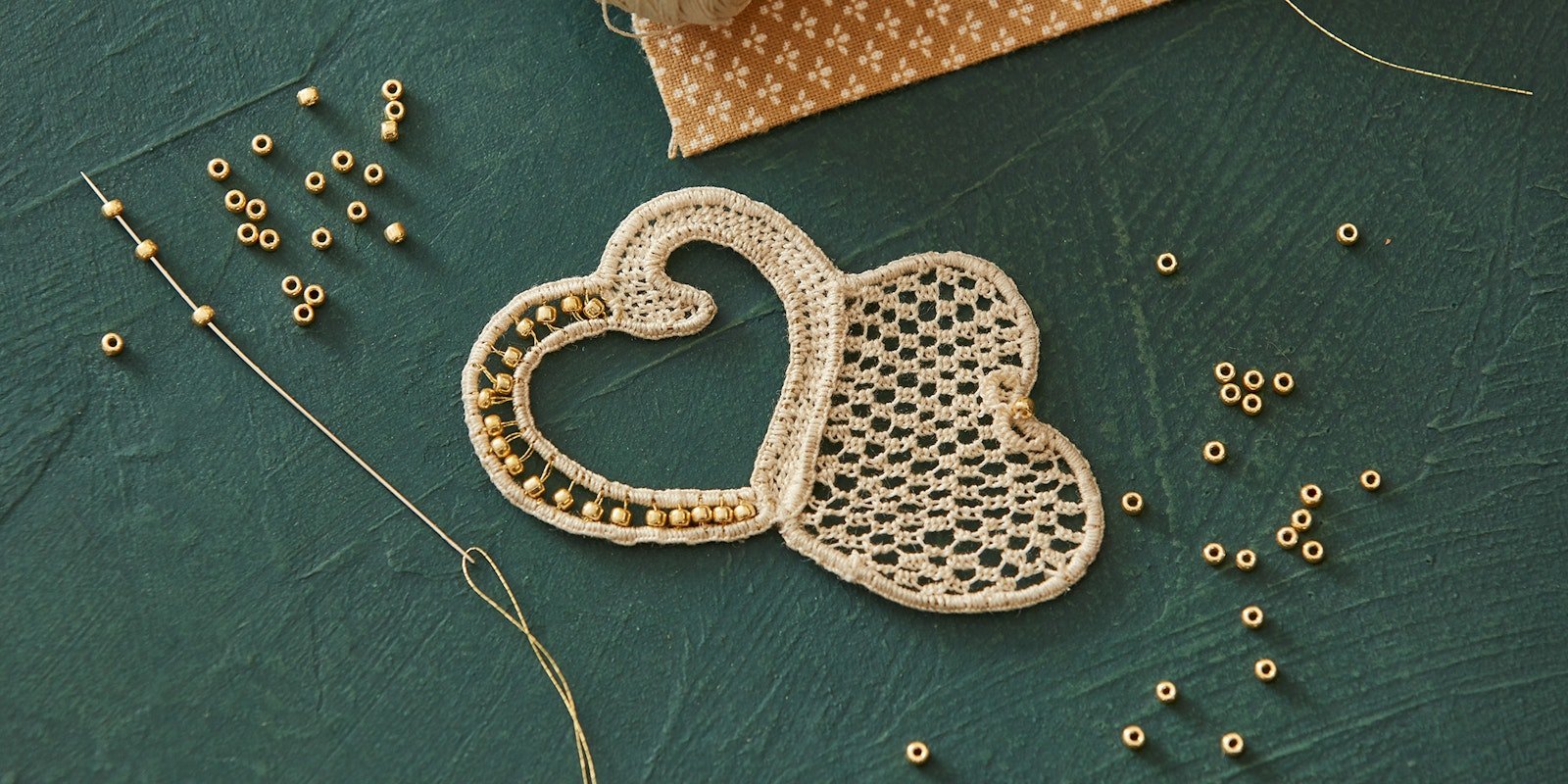Anyone traveling to Belgium will be awestruck by the lace they find there, as well as by the country’s cultural history. Belgium, a small country nestled in northwestern Europe, has traditionally displayed great prowess in the art of lacemaking. Over the sixteenth, seventeenth, and eighteenth centuries, the lacemakers of Bruges, Brussels, Mechelen, Antwerp, and Zele became superbly skilled and proficient in needle-lace techniques (sometimes referred to as “point lace”), bobbin lace, and mixed laces using both needle and bobbins. Belgium was known to have the greatest lacemaking centers in all of Northern Europe.
 Kathi Rotella’s sweet Belgian needle-lace double-heart motif represents the bond of love between two people.
Kathi Rotella’s sweet Belgian needle-lace double-heart motif represents the bond of love between two people.
Flanders, a region now consisting of parts of Belgium, France, and the Netherlands, became the center for producing exquisite needle lace with an incomparable aesthetic. The creation of needle lace seems a rather simple and undemanding challenge because the lacemaker uses only a needle and thread and works over an outlined design on parchment. But the true secret to the development of such lovely historical needle lace lies not only in the skill and dexterity of the lacemakers but also in the finely spun linen fiber that allowed them to create such beautiful pieces.
Historically, the Flanders region provided all the natural resources needed to grow the annual tall willowy flax plant with tiny blue flowers with an inner core containing the long fibers that can be extracted and then spun to produce a very fine but strong linen thread. Cultivation was arduous in the wet and cool environment but not too difficult for the Belgian people, who took deep pride in their prestige fiber. The fine linen threads from Belgium were known to be of the highest quality and were often more valued than silver or gold. With this exceptional linen fiber at the lacemakers’ disposal, needle lace became an outstanding and prized achievement.
 Point de gaze nineteenth-century needle-lace cuff from Brussels, purchased by Kathi Rotella. This glorious example of Belgian needle lace served as her inspiration for this project.
Point de gaze nineteenth-century needle-lace cuff from Brussels, purchased by Kathi Rotella. This glorious example of Belgian needle lace served as her inspiration for this project.
Hidden in my personal collection is a point de gaze (literally translated from the French as “gauze point”) nineteenth-century needle-lace cuff from Brussels that I purchased long ago. This type of lace is light, airy, and gauzelike because of the appearance of the background mesh. It consists of a variety of detached-buttonhole stitches, which create both dense and open areas within the outlined motifs. The repeated upright flower motifs joined by gentle swags of outlined pearls are beautifully balanced. What mystery does this lace cuff hold? What might these motifs represent? Who was this made for? I have so many questions. Unlike Nancy Drew, I will never solve the mystery of my lace cuff, but I nonetheless will enjoy its magnificence, and it served as partial inspiration for this project.
The other source of my inspiration came from the Nancy Drew book The Secret in the Old Lace, which reveals a romance in Bruges, Belgium. My pattern is of two joined hearts that represent the bond of love between two people. No mystery message in my design, just a message of love. I stitched it in the traditional needle-lace technique, using basic buttonhole, corded single Brussels, and treble Brussels stitches (the latter two are variations of the detached-buttonhole stitch).
Interested in trying your hand at needle lace? This pattern and its companion article can be found in the Winter 2018 issue of PieceWork.
Also, remember that if you are an active subscriber to PieceWork magazine, you have unlimited access to previous issues, including Winter 2018. See our help center for the step-by-step process on how to access them.
Kathi Rotella is a lacemaker and an active member of the International Organization of Lace, Inc. (IOLI) and the Embroiderers’ Guild of America (EGA). She holds an MA in Clothing, Textiles, and Design from the University of Nebraska at Lincoln and is the founder of Living Lace of Omaha.
Originally published January 23, 2019; updated May 27, 2024.

